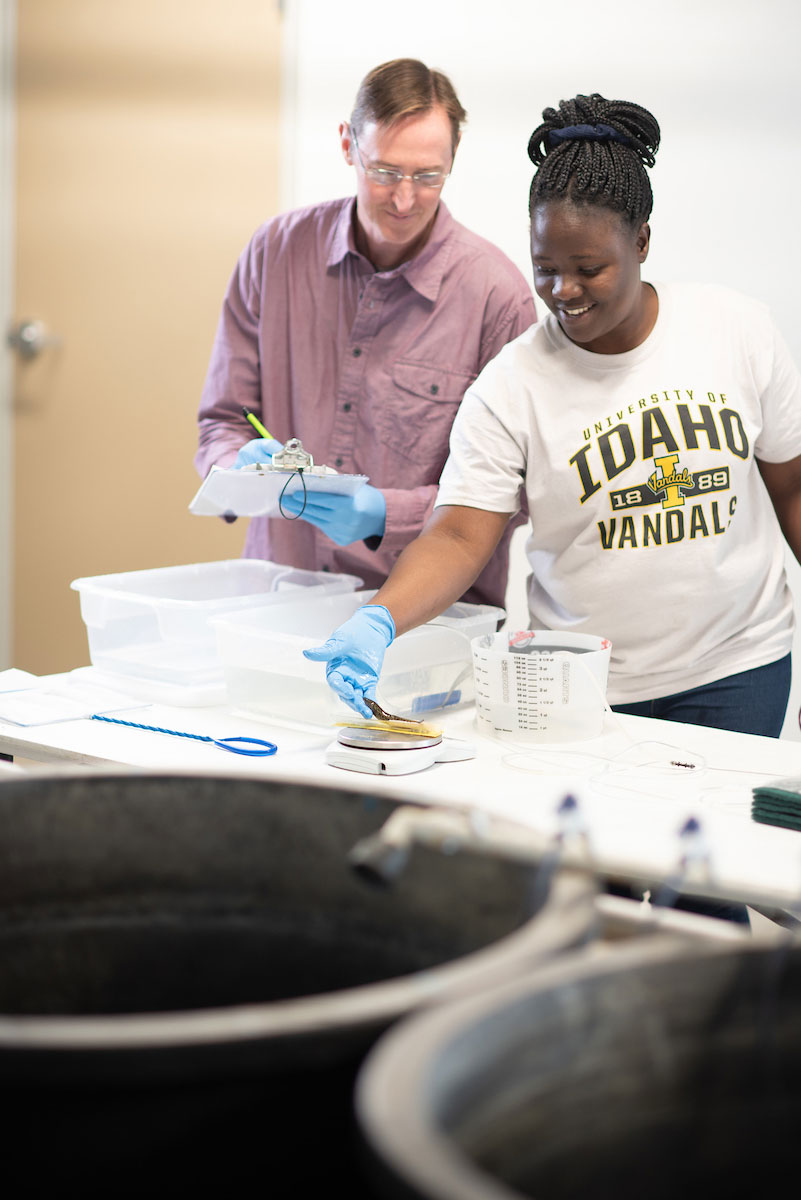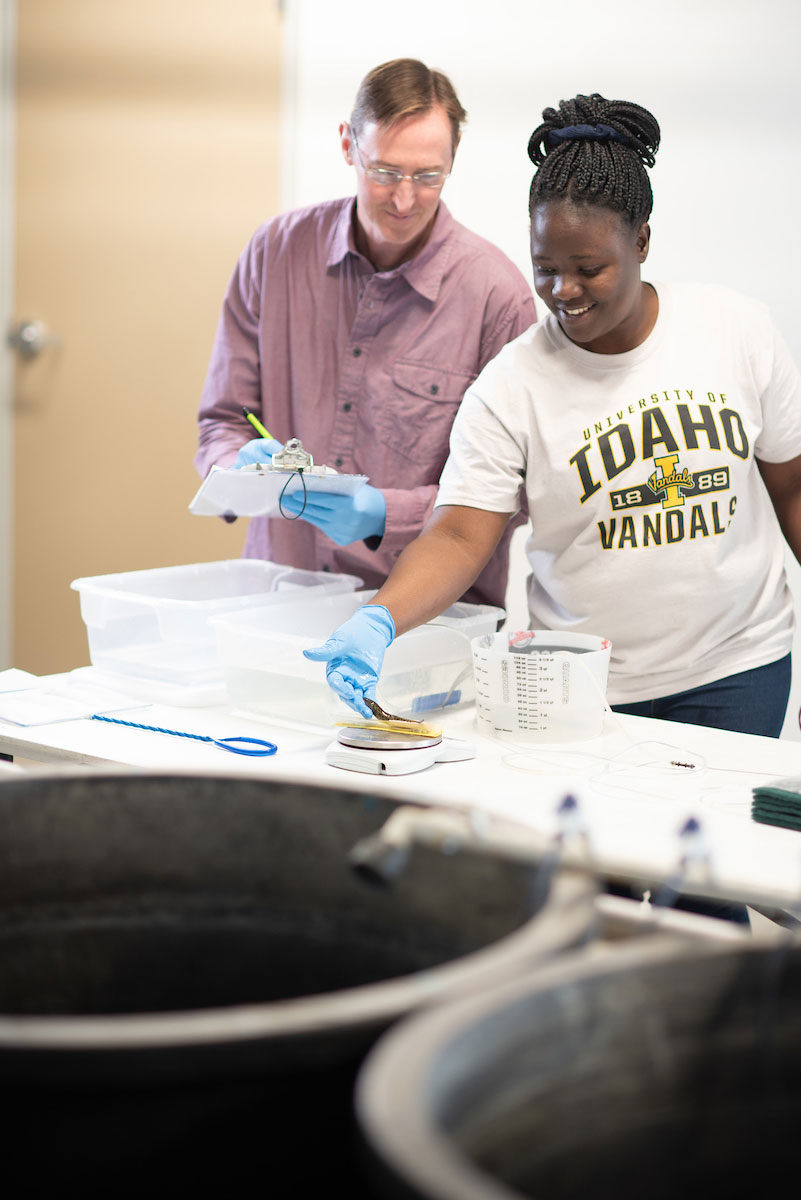Burbot Bounce Back
Researchers tweak fish’s biology for aquaculture industry
Moureen Matuha points at a group of blotchy brown fish with eel tails and catfish heads huddled together like a pile of sleeping puppies on the bottom of the tank.
“These burbot are napping. They actually nap,” said Matuha, a University of Idaho doctoral student studying environmental science in Moscow. “But it’s chaos when you feed them.”
Burbot are staging a comeback in Idaho. Ken Cain, a professor in the Department of Fish and Wildlife Sciences and associate director of U of I’s Aquaculture Research Institute, has helped rebuild Idaho’s burbot population. The fish numbered fewer than 50 in the Idaho wild in the early 2000s, but a conservation effort led by the Kootenai Tribe has increased Idaho’s wild population to around 20,000 adults. The repopulation effort was so successful the Idaho Department of Fish and Game will initiate a recreational burbot fishery in 2019 along the Kootenai River.
“We have to domesticate the fish. We are trying to fine-tune their growth and reproductive biology for the aquaculture setting.” Ph.D. student Neil Ashton
Now Cain wants to shift from conservation to commercial aquaculture. Currently, burbot are not farmed commercially for food in the United States.
“We have to domesticate the fish,” said doctoral student Neil Ashton in national resources. “We are trying to fine-tune their growth and reproductive biology for the aquaculture setting.”
Life as a Larvae
Baby burbot present a challenge for aquaculture because they go through what scientists call a larval stage once hatched.
“When they hatch, they are so small you can’t feed them an artificial diet like young trout or salmon,” said Cain, who is in U of I’s College of Natural Resources. “They are basically the size of an eyelash.”
Instead, baby burbot feed on small plankton called rotifers before graduating to brine shrimp and later artificial pellet feed. Ashton, who is from Seattle, Washington, has spent the past few years tweaking burbot diets and nursery conditions to increase survival rates.
“When they hatch, they are so small you can’t feed them an artificial diet like young trout or salmon. They are basically the size of an eyelash. ” Professor Ken Cain
“A fish can carry a million eggs, and survival is low in the wild,” Ashton said. “We are getting up to 20 percent survival through larval stages. That is a really good percentage for these fish.”
But raising live food is labor-intensive and expensive compared to pellet feed. Cain hopes researchers can reduce the time baby burbot spend eating live food by either selecting for fish that grow fast or introducing smaller dry diets at earlier stages in the life cycle.
Once they do start feeding on larger food, burbot can become cannibalistic, eating their fellow burbot. Ashton learned he could discourage this behavior by providing an abundance of food and removing any large fish from the tank.
In the future, the team will test how different commercial feeds affect burbot growth and health. For example, the Soy Aquaculture Association has provided a grant to look into soy-based food as a more sustainable protein source for aquaculture. The data gained will inform the feeding recommendations Cain provides to fish farmers.
Ice, Ice Burbot
Burbot are a coldwater fish. Adults only spawn in late winter when the water is just above freezing. If the water temperature rises even a few degrees, most eggs won’t hatch.
On the plus side, Cain said the fish will likely grow well across northern states. But inducing a spawning event and caring for eggs and larvae can be tricky. Matuha is varying temperature and day length, which is short in late winter, to see if adult burbot spawn outside of their regular spawning time.
In addition, the team wants to create sterile fish. They shock the eggs with quick changes in temperature and pressure to induce genetic changes that result in sterilized fish. The researchers are now testing how far along in development they should wait before shocking the eggs.
“In some areas there may be concerns about them escaping and becoming invasive species,” Cain said. “If we can produce sterile fish, producers may be able to grow them in places where they might not otherwise be allowed.”
In addition, Ashton said the energy the fish usually put toward growing sex organs would be shifted to increased body size.
The Fish Technology Program at the College of Southern Idaho in Twin Falls and a handful of fish farmers are growing the fish in aquaculture environments usually used for trout. Like many trout farms in Idaho, spring water flows through their tanks at 59 degrees Fahrenheit.
“We have found that burbot grow really well in this water,” Cain said. “It is a good way for trout farmers to diversify what they are producing.”
Burbot and Chips
In 2017, Cain’s group worked with U of I Aquaculture Extension Specialist Gary Fornshell, The College of Southern Idaho and Leo Ray, owner of the Idaho Fish Breeders company, to provide burbot to a southern Idaho restaurant. Roughly 150 customers who ordered burbot – a mild, white meat – completed surveys and overall the fish received rave reviews.
“If you wrap it in bacon, it tastes a lot like a scallop,” Ashton said.
As part of her project, Matuha, who is from Uganda, will continue studying the potential markets for burbot, including surveying other Northwest restaurants. She will also investigate other uses for the fish. In Europe, the eggs are used as caviar, the skin made into designer leather purses and the liver sold as a delicacy.
“Can we look to Europe to see what they have done and the feasibility of selling these items here?” Matuha asked. “Maybe Americans will not be interested, but it would be good if there’s another way to contribute money to the industry.”
This project was funded under the National Institute of Food and Agriculture award 2016-38500-25755 given to the University of Washington and awarded to the University of Idaho by the Western Regional Aquaculture Center. The total amount of federal funding for the project is expected to be $417,000, which amounts to 100 percent of the total cost of the project; to date $60,900 has been provided.

Article by Leigh Cooper, University Communications and Marketing.







